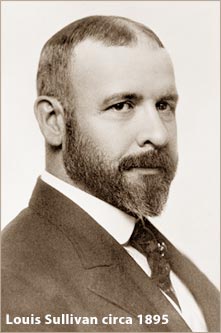

ouis Sullivan was a visionary genius, a titan of American Architecture. Known as the "Father of the Skyscraper" and the "Father of Modernism," Sullivan brought changes to the face of the America's urban landscape on a truly heroic scale.
Over the course of his brilliant career, he successfully raised the average American's awareness of architecture along with its importance in shaping our society. Sullivan believed that America should have its very own architectural identity, an identity expressing our individuality, an architectural identity capable of evolving to keep up with our rapidly developing nation. For his significant accomplishments and his contributions to architecture, the American Institute of Architects awarded Louis Sullivan its highest honor, the AIA Gold Medal.
Louis Sullivan hired and mentored the young, unruly Frank Lloyd Wright (a.k.a. "Master of Modern" and "Father of the Prairie School") as chief draftsman during the massive Chicago Auditorium project in 1887, at the start of Wright's storied career. Sullivan is credited for the inspiration he provided in the development of the Chicago Prairie School- while Wright receives the lion's share of the acclaim. Later, in well-deserved tributes to his mentor, Frank Lloyd Wright referred to Louis Sullivan as "der Lieber Meister," or Dear Master.
"The function of a building must...organize its form...," Sullivan once wrote. Distilled From this passage comes the well known Sullivan principle: "Form Follows Function."
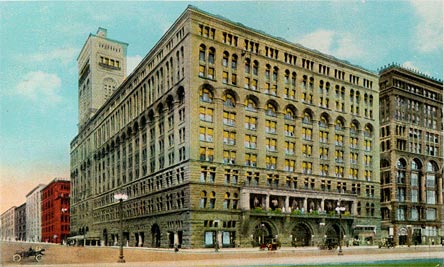
Provenance
Chicago Auditorium Building, Chicago, Illinois. Designed by Chicago's Golden Age architects Dankmar Adler and Louis Sullivan. Completed in 1889 in the Romanesque Revival style, this architectural masterpiece is the most famous achievement of Louis Sullivan's illustrious career.
Within the 17-story rusticated granite and limestone structure were housed a first-class hotel, an office complex and the opulent Chicago Auditorium Theater. In 1889 Auditorium Building was the biggest, tallest, heaviest and most expensive building in the US. The Auditorium remains functional to this day, being a perpetual source of civic pride to Chicagoans. The Auditorium Building was placed on the National Register of Historic Places in 1970. In 1975 it was declared a National Historic Landmark.
For a long while after the Auditorium Theater opened, it was the model for futuristic technological advances in the fields of acoustics and electricity. The Theater was the first on a large-scale to be lit entirely by electric lighting. There were 3500 bare carbon-loop bulbs being lit throughout the theater, plus 150 footlights and scores more operating on the stage.
After having collaborated to create ten theaters in the Chicago area, the team of Adler and Sullivan was clearly ahead of its time in the field of acoustics. Dankmar Adler lead the team on the Theater project. His aim was to take the Auditorium Theater's acoustics to an unsurpassed level: to be the absolute best in the world. This challenge was monumental not only because the vast proportions of the structure, but because the auditorium was intended to host a wide spectrum of world-class events: speaking engagements, symphony concerts, grand operas, ballet productions, live theater performances, political conventions, and the list goes on. (Theodore Roosevelt and Booker T. Washington were two of the early speakers.)
Dankmar Adler wanted patrons all around the 4237 seat auditorium to hear any given performance as if it were held in a small theater. Through painstaking experimentation and calculation, Adler created a masterpiece of acoustics in 1889 which sounds incredibly good to this day. (The many concerts and ballets my wife and I attended over the years attest to this.) Adler carried out the feat of "acoustical magic" (as it was contemporaneously labeled) by erecting a series of sound-channeling perimeter arches, developing an exact downward-sloping floor plan, constructing the shapes and angles of interior walls and fixtures in ways that eliminated unwanted sound reflection, and by selecting sound absorbing materials for the ornamental elements, carpeting and seat fabrics.
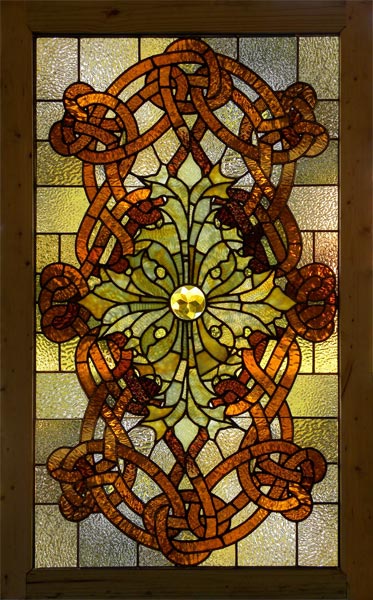
About Window AE576
The stained glass window shown at left, AE576, was originally installed in the ceiling of the Auditorium Theater at the location shown in the cross section below. More information about the Auditorium can be found here.
This stained glass window was designed by Louis Sullivan for the Chicago Auditorium Theater as part of a 12-panel Grand Skylight. The extraordinarily grand skylight spanned the width of the auditorium's ceiling, notably elevating the Auditorium's opulent interior. The Skylight's design featured twelve matching central stained glass windows, each displaying an intertwining knotted pattern. Surrounding each of these twelve panels were less-intricate stained glass panels, which served to highlight the 12 central (or focal) windows. AE576 is one of the original twelve central windows which made up the grand skylight.
Because of its energetic, flowing pattern, its rich coloration and the aqueous translucent nature of its mouth-blown Muff Glass (See Glossary), the skylight was arguably the crown jewel of the Auditorium Theater, as the Theater itself was the crowning jewel of the larger-than-life 17 story Auditorium Building. Note: the Auditorium Building was the tallest, heaviest, most expensive building in existence when it was built.
The 12-panel Auditorium Skylight was a key aesthetic element in this achievement, and it is lasting beauty is tangible proof of Sullivan's creative genius. Once the Skylight caught their attention, first-time patrons were known to slow to a snail's pace when they inadvertently halted to stare up at the radiant glass ceiling. The Chicago Tribune contemporaneously noted that "when eyeing the Skylight for the first time patrons were given to congest the aisle ways," much to the consternation of the management.
When historians think Chicago Auditorium, they automatically think Louis Sullivan. Because of his boundless contributions as lead architect on the iconic project, Sullivan deserves the artistic credit given him. But he didn't do it by himself. Along with his partner Dankmar Adler, Sullivan had a vast pool of collaborators in all fields. For the physical creation of the stain glass windows, Louis Sullivan collaborated with Chicago's renowned Healy and Millet Art Studios. The significant contributions made by George Healy and Louis Millet must be duly noted, for they translated Sullivan's two-dimensional skylight drawings into color-specific, full-size patterns for their stained glass craftsmen to follow.
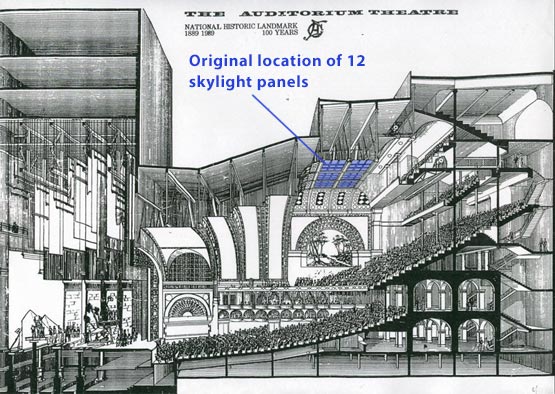
Louis J. Millet was educated at L'Ecole de Beaux Arts in Paris, taught at Chicago's preeminent Art Institute from 1886 to 1918 and, of significance, he founded the groundbreaking Chicago School of Architecture in 1893. George Healy and Louis Millet were at their zenith in the field of artistic stained glass fabrication in the latter portion of the nineteenth century, competing with the finest glass studios anywhere in the world. Not only does this panel demonstrate H And M Studios' expertly skilled craftsmanship, but, notably, the selection of all its glass (colors, textures, types) is outstanding.
The role of "glass selector" in stained glass window construction is seldom talked about, yet the glass selector's choices were a vital part in determining a window's specific coloration, aesthetic balance, nuance and character. As I view examine this window, every glass type, every sheet, every jewel, show deliberate purpose, all exemplary of the finest materials that could be obtained. Every piece of the field glass is mouth blown Muff Glass (see my glossary of terms) of the most crystalline and translucent variety. In the ripple textured glass can be seen a remarkable representation of the then relatively "new" opalescent type glass. Opalescent glass possesses a warm, semi-translucent fieriness, brought about in part by the use of arsenic in its formulation. Each piece of rippled textured glass included in this composition is of the highest quality, hand-rolled variety, created during Chicago's finest glass making period.
Only 5 of 12 Skylight Panels Remain
In the 1960s the auditorium underwent major restoration. The skylight windows were removed due to condition problems, then, sadly, they were replaced with replicas. Only five of the original twelve panels now exist. The rest were lost to history.
The locations of known windows are listed below.
- Roosevelt University in Chicago
- Art Institute of Chicago
- An anonymous collector in Southern California
- The Smith Museum of Stained Glass Windows of Chicago
- The window I offer here for sale, AE576
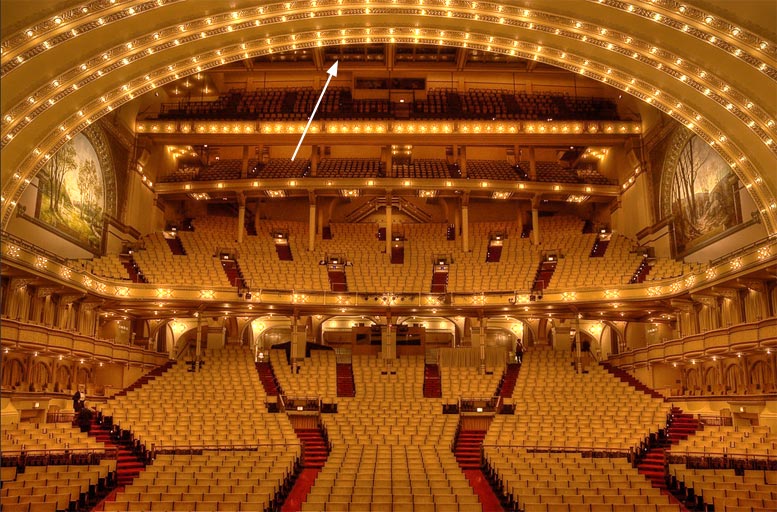
The original location of the skylight panels is indicated in this photo.
AE576 is in private hands about an hour's drive from Chicago. I do not own the window, I am acting as an agent on behalf of the owner to sell it. Please note: the frame surrounding the stained glass window is of simple pine construction. The present frame's purpose is to safely protect the stained glass window until a permanent frame is chosen by its purchaser.
Since it was acquired by its present owner, AE576 was expertly restored to pristine condition by Drehobl Brothers Art Glass Company, one of Chicago's most experienced stained glass studios & restoration specialists. Founded in 1919, Drehobl Brothers is presently the oldest surviving art glass studio in Chicago. Their restoration work on this skylight panel is superb. The window has been completely re-leaded with specially ordered caming to match the original, all background glass is 100% original to the Auditorium skylight, and a few of the "inner" design pieces have been replaced with period matching glass. This window received the ultimate restoration achievable. Having entrusted the work to the very best, the restoration is as fine and pure as it gets.
One of the matching panels to AE576 has long been on display at the Chicago Art Institute. Recently I brokered another of the five existing original skylight panels to The Smith Museum of Stained Glass Windows in Chicago. The Smith Museum, which houses the preeminent collection of stained glass windows in the world, intends the Sullivan skylight window to be on permanent display when the collection relocates to its new permanent facility in Chicago.
A window may have merit based upon its outstanding design, resplendent coloration or the gem-like quality of its mouth-blown glass- and this particular window has all of those fine characteristic. Yet because of its provenance, this window answers to a higher standard. Simply stated, this window is Important.
On occasion, finer examples of Louis Sullivan have come upon the market, and the corresponding sales prices have proven to be remarkably strong. (Most of these examples, however, are not stained glass windows.) The noteworthy selling prices appear to indicate that the best Sullivan objects, in addition to their historical and cultural significance, are also seen as worthy financial investments. It is worth pointing out that among the Louis Sullivan items to come onto the market, no finer or more important stained glass window than this has appeared.
In my forty-four years as a dealer of antique stained glass windows, I have owned my share of Tiffany Windows. None of those Tiffany Windows compared in rarity or historical significance to this elite Louis Sullivan Window.
I unconditionally guarantee the authenticity of this window as being one of the original twelve Louis Sullivan Skylight panels installed in the Chicago Auditorium Theater.
Return to viewing the AE576 window.


